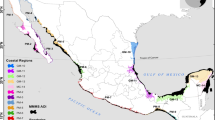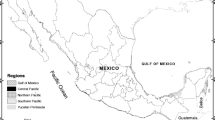Abstract
Existing at the interface of land and sea, in regions of low topographic relief, mangroves are likely to be some of the first ecosystems that undergo spatial modification due to sea-level rise. The mangrove ecosystems of the Gulf of Papua New Guinea are some of the largest and most pristine in the Asia–Pacific region; they have not been subject to clearance for crustacean farming nor suffered from land reclamation projects. This article establishes through analysis of a time series of aerial photography and satellite imagery from the period 1973–2007, that there have been substantial changes in the distribution of mangroves in this region. These changes include the seaward progradation of the Purari Delta and the regression of the Kikori Delta by an average of 43 m year−1 at its most seaward point. While these findings are likely to be continuations of long-term trends, it is probable that they can be explained by a variety of interacting factors including climate change, sea-level rise, subsistence in the northern Gulf of Papua and changes in sediment dynamics.



Similar content being viewed by others
References
Allison, M.A., C.A. Nittrouer, and L.E.C. Faria. 1995. Rates and mechanisms of shoreface progradation and retreat downdrift of the Amazon River mouth. Marine Geology 125: 373–392.
Alongi, D.M., P. Christoffersen, F. Tirendi, and A.I. Robertson. 1992. The influence of freshwater and material export on sedimentary facies and benthic processes within the Fly Delta and adjacent Gulf of Papua (Papua New Guinea). Continental Shelf Research 12: 287–326.
Birkeland, C. 1985. Ecological interactions between tropical coastal ecosystems. UNEP Regional Seas Reports and Studies No. 73, p. 71.
Bruun, P. 1962. Sea level rise as a cause of shore erosion. Journal of the Waterways and Harbours Division, Proceedings of the American Society of Civil Engineers 88: 117–130.
Church, J.A., J.M. Gregory, P. Huybrechts, et al. eds. 2001. Climate change 2001: The scientific basis. Contribution of working group 1 to the third assessment report of the intergovernmental panel on climate change, 639 pp. Cambridge: Cambridge University Press.
Church, J.A., and N.J. White. 2006. A 20th century acceleration in global sea-level rise. Geophysical Research Letters 33: 1–4.
Coulthard-Clark, C.D. 2000. Australia’s military map-makers. The royal Australian survey corps 1915–96. Melbourne, Australia: Oxford University Press.
Cragg, S. 1983. The mangrove ecosystem of the Purari Delta. In The Purari—Tropical environment of a high rainfall river basin, ed. T. Petr, 295. The Hague: Dr. W. Junk Publishers.
Definiens. 2000. eCognition application notes. Integrating aerial photos and satellite images, vol. 1, no. 2, September 2000. http://www.definiens.com.
Duke, N.C., M.C. Ball, and J.C. Ellison. 1998. Factors influencing biodiversity and distributional gradients in mangroves. Global Ecology and Biogeography Letters 7: 27–47.
Ellison, J.C. 1993. Mangrove retreat with rising sea-level, Bermuda. Estuarine, Coastal and Shelf Science 37: 75–87.
Ellison, J.C. 1997a. Mangrove community characteristics and litter production in Bermuda. In Mangrove forests of the Latin America and Africa regions, ed. B. Kjerfve, L.D. Lacerda, and E.S. Diop, 5. UNESCO, Paris.
Ellison, J.C. 1997b. Mangrove ecosystems of the Western and Gulf Provinces, Papua New Guinea, a review. Science in New Guinea 23: 1–15.
Ellison, J.C. 1998. Holocene stratigraphic records of vegetation change and sedimentation from the Ajkwa River Estuary mangroves, Irian Jaya. Report presented to P. T. Freeport Indonesia Company, 300 K Expansion Project, Tembagapura, Irian Jaya, Indonesia.
Ellison, J.C. 2000. How South Pacific mangroves may respond to predicted climate change and sea level rise. In Climate change in the south Pacific: Impacts and responses in Australia, New Zealand, and Small Islands States, ed. A. Gillespie, and W.C.G. Burns, 289. Dordrecht: Kluwer Academic Publishers.
Ellison, J.C. 2005. Holocene palynology and sea-level change in two estuaries in Southern Irian Jaya. Palaeogeography, Palaeoclimatology, Palaeoecology 220: 291–309.
Farr, T.G., P.A. Rosen, and E. Caro, et al. 2007. The shuttle radar topography mission. Reviews of Geophysics 45 (2), Art. No. RG2004.
Field, D.D. 1995. Impact of expected climate change on mangroves. Hydrobiologica 295: 75–81.
Floyd, A.G. 1977. Ecology of the tidal forests in the Kikori—Romilly sound area, Gulf of Papua. Ecology Report No.4. Lae, Morobe: Division of Botany, Office of Forests, Department of Primary Industry.
Gilman, E., J. Ellison, and R. Coleman. 2007. Assessment of mangrove response to projected relative sea-level rise and recent historical reconstruction of shoreline position. Environmental Monitoring and Assessment 124: 1–3.
Gilman, E., J.C. Ellison, V. Jungblut, et al. 2006. Adapting to Pacific Island mangrove responses to sea level rise and climate change. Climate Research 32 (3): 161–176.
Haines, A.K. 1979. An ecological survey of fish of the lower Purari River system, Papua New Guinea. Waigani, Papua New Guinea: Office of Environment and Conservation; Konedobu, Papua New Guinea: Department of Minerals and Energy.
Hammermaster, E.T., and J.C. Saunders. 1995. Forest resources and vegetation mapping of Papua New Guinea. PNGRIS Publication No. 4. Commonwealth Scientific and Industrial Research Organisation.
IPCC. 2007. Climate change 2007: The physical science basis, ed. S. Solomon, et al. Cambridge: Cambridge University Press.
Kauth, R.J., and G.S. Thomas. 1976. The Tasseled Cap—A graphic description of spectral-temporal development of agricultural crops as seen by Landsat. In LARS: Proceedings of the symposium on machine processing of remotely sensed data, 4B-41. West Lafayette, IH: Purdue University.
Kompas, T., and R. Kuk. 2008. Managing the Gulf of Papua prawn fishery: Sustainability, maximum returns and cooperation between commercial fishing and indigenous fishing communities. Pacific Economic Bulletin 23 (1): 29–38.
Liem, D.S., and A.K. Haines. 1977. The ecological significance and economic importance of the mangrove and estuarine communities of the Gulf Province, Papua New Guinea. Purari River (Wabo) hydro-electric scheme. Environmental Studies 3: 1–35.
Lu, D., P. Mausel, E. Brondízio, and E. Moran. 2004. Change detection techniques. International Journal of Remote Sensing 25 (12): 2365–2407.
Lucas, R.M., J.C. Ellison, A. Mitchell, B. Donnelly, M. Finlayson, and A.K. Milne. 2002. Use of stereo aerial photography for quantifying changes in the extent and height of mangroves in tropical Australia. Wetlands Ecology and Management 10: 161–175.
McAlpine, J.R., G. Keig, and R. Falls. 1983. Climate of Papua New Guinea. Canberra: CSIRO and The Australian National University Press.
Milliman, J.D. 1995. Sediment discharge to the ocean from small mountainous rivers: The New Guinean example. Geo-Marine Letters 15: 127–133.
National Statistical Office of PNG. 2000. PNG Census 2000 National Report. Port Moresby, Papua New Guinea: National Statistical Office of PNG.
Paijmans, K. 1976. New Guinea Vegetation. Canberra: CSIRO and ANU, Australian National University Press.
Pernetta, J.C., and P.L. Osborne. 1990. Deltaic floodplains: The mangroves of the Gulf of Papua and the Fly River, Papua New Guinea. In Implications of expected climate changes in the South Pacific region: An overview, ed. P.J. Hughes, 200. Prepared in cooperation with ASPEI, SPREP, Nairobi, Kenya.
Pernetta, J. 1993. Mangrove forests, climate change and sea level rise: Hydrological influences on community structure and survival, with examples from the Indo-West Pacific, ed. J. Pernetta, International Union for Conservation of Nature and Natural Resources Marine and Coastal Areas Programme, ISBN 283170183X, 9782831701837.
Pickup, G. 1983. Sedimentation processes in the Purari River upstream of the delta. In The Purari: Tropical environment of a high rainfall river basin, ed. T. Petr, 205. The Hague: Junk.
Pugh, D., J. Hunter, R. Coleman, and R. Watson. 2002. A comparison of historical and recent sea level measurements at Port Arthur, Tasmania. International Hydrographic Review 3: 3–23.
Rasolofoharinoro, B.M., F. Bellan, and M.G. Aizpuru. 1998. A remote sensing based methodology for mangrove studies in Madagascar. International Journal of Remote Sensing 19 (10): 1873–1886.
Robertson, A.I., and D.M. Alongi. 1995. The role of mangrove forests in organic carbon export to the tropical coastal ocean: A preliminary mass balance for the Fly Delta (Papua New Guinea). Geo-Marine Letters 15: 134–139.
Robertson, A.I., D.M. Alongi, and P. Dixon. 1998. The influence of fluvial discharge on pelagic production in the Gulf of Papua, northern Coral Sea. Estuarine, Coastal and Shelf Science 46: 319–331.
Robertson, A.I., P.A. Daniel, and P. Dixon. 1991. Mangrove forest structure and productivity in the Fly River estuary, Papua New Guinea. Marine Biology 111: 147–155.
Robertson, A.I., and N.C. Duke. 1987. Mangroves as nursery sites: Comparisons of the abundance and species composition of fish and crustaceans in mangroves and other nearshore habitats in tropical Australia. Marine Biology 96 (2): 193–205.
Shearman, P.L., J.E. Bryan, J. Ash, B. Mackey, and B. Lokes. 2009. Forest conversion and degradation in Papua New Guinea 1972–2002. Biotropica 41 (3): 379–390.
Stewart, R.W., B. Kjerfve, J. Milliman, and S.N. Dwivedi. 1990. Relative sea-level change: A critical evaluation. UNESCO Reports in Marine Science 54: 1–22.
Thom, B.G., and L.D. Wright. 1983. Geomorphology of the Purari delta. In: The Purari—Tropical environment of a high rainfall river basin, ed. T. Petr, 47. The Hague: Junk.
Walsh, J.P., and C.A. Nittrouer. 2004. Mangrove-bank sedimentation in a mesotidal environment with large sediment supply, Gulf of Papua. Marine Geology 208: 225–248.
Walsh, J.P., C.A. Nittrouer, C.M. Palinkas, A.S. Ogston, R.W. Sternberg, and G.B. Brunskill. 2004. Clinoform mechanics in the Gulf of Papua, New Guinea. Continental Shelf Research 24 (19): 2487–2510.
Wang, Z., and C.A. Stein. 1992. Subsidence of the Gulf of Papua in the Cenozoic. Tectonophysics 205: 409–426.
Wolanski, E., and M. Eagle. 1991. Oceanography and fine sediment transport, Fly River estuary and Gulf of Papua. In Coastal engineering, climate for change, ed. R.G. Bell, T.M. Hume and T.R. Healy, vol. 21, 453–457. Proceedings of 10th Australasian conference on coastal and ocean engineering. Water Quality Centre Publication.
Woodroffe, C. 1992. Mangrove sediments and geomorphology. In Tropical mangrove ecosystems, ed. A.I. Robertson and D.M. Alongi, 7–41. Washington, DC: American Geophysical Union.
Acknowledgements
The author would like to thank J. Ash, J. Bryan, J. Luick and J. Chappell for their insightful comments and Oilsearch Pty Ltd for providing access to their bathymetric data. I would also like to thank the two reviewers for their improvements in the manuscript.
Author information
Authors and Affiliations
Corresponding author
Electronic Supplementary Material
Below is the link to the electronic supplementary material.
Rights and permissions
About this article
Cite this article
Shearman, P.L. Recent Change in the Extent of Mangroves in the Northern Gulf of Papua, Papua New Guinea. AMBIO 39, 181–189 (2010). https://doi.org/10.1007/s13280-010-0025-4
Received:
Revised:
Accepted:
Published:
Issue Date:
DOI: https://doi.org/10.1007/s13280-010-0025-4




